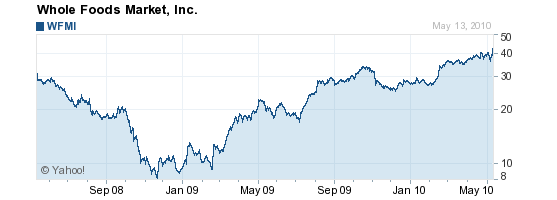Yoo-hoo, America. About these prices?!?
Bob Wells | May 14, 2010

Not to be a nag but, hey American businesspeople, what’s up with the astounding prices we’re seeing for everyday things? By way of evidence to support my griping, I present here an illustrated, random assemblage of consumer items whose prices left me amazed in recent days.

Replacement knob for stove: $60
Now, certain cooks that I know are inevitably going to wear out those little knobs on top of the stove that control the gas burners, right? Well, over the years she has. But the last time I ordered one, the price had shot up to (counting mailing) a cool $60. For a little plastic knob. KitchenAid, and the third party to whom they’ve (all too characteristically) outsourced the provisioning of these knobs do have their nerve, don’t you think?

Whole Foods candy bar: $5
Then there’s that display of candy bars at Whole Foods — one of the myriad of “impulse items” positioned right by the checkout line so everyone has to go by them. Well, it’s actually more a checkout gauntlet, festooned on both sides now with rows and rows of impulse items. But, come on, folks. Has it come to this? Five dollars for a candy bar?
I was quietly stewing, and taking pictures, until now, when I’m finally moved to document my pain. What moved me into action was when I espied, again at Whole Foods, what has become of the price of asparagus. I do try to buy organic when I can, but $5.99 a pound for organic asparagus. Hmmmm…I think I’ll go with the conventional, at a mere $3.99 a pound, this time around. Time to switch to Safeway or Vitamin Cottage?
You will observed that, since the bottom of our economy’s little flirtation with Great Depression 2 in 2008, the price of Whole Foods stock has risen 500 percent.

Five-fold increase in Whole Foods stock. Glad someone's not suffering. (Source: Yahoo)
Changing grocery stores is one way to rebel, I s’pose. An even more radical idea has been percolating in my mind for a few years now: moving to Mexico, moving to Ecuador or moving to Panama.
I travel, to Mexico in particular, and I know that prices for many things in my favorite corner of Mexico, the Yucatan Peninsula, are much lower than here. Rather palatial homes in Merida are going for $200,000, nice ones for $100,000, and if you don’t believe me, check out of the listings at Tierra Yucatan. Merida has so much culture and class and beautiful architecture, and my friends who live there love it — except, perhaps, for about five months of the year when it gets really hot.
Ecuador and Panama: a more ambitious escape
Even more adventurous is the scenario in my mind about moving to Quito or Cuenca, Ecuador. Gorgeous furnished apartments in a city of many universities, Cuenca, go for $600-800 a month. Very nice condos for under $150,000. A four-course mid-day meal at an elegant restaurant — and you wouldn’t believe the produce in this verdant climate — goes for $1.50. At 8,000 feet, but on the equator, days are in the 70s and nights in the 50s, a climate that Kent Zimmerman, formerly of Boulder and now residing much of the year in Cuenca, describes as “Aspen in the summer, year-round.” Kent has a couple of blogs (one and two) where you can tune in on his enthusiasm for South America.
Another place is Panama. I’ve talked with Zach Daudert, he of Boulder’s People Productions and Boulder Digital Arts. He spends half his year there and loves the warmth, the beaches, the lifestyle and the prices.
It’s no wonder that a growing number of American boomers, as they move into their retirement years, also known as the fixed-income years, are seriously considering a move south. And not just considering. They’re flocking. An amazing number of them are writing blogs. Googling the blogs will give you a good sense of what it’s like to take this particular plunge. You have to be willing to learn Spanish and, yes, overlook poverty, stray dogs and some other not-so-nice things. In return, you’re in a beautiful New World. And maybe one where the capitalists aren’t going wild with ridiculous prices?
(Got some stories of your own to tell about eye-popping prices these days? Maybe it’d be therapeutic for both of us if you to share them in a comment, entered into the comment form below.)
A somewhat rewritten version of this story appeared on my blog on Huffington Post.

